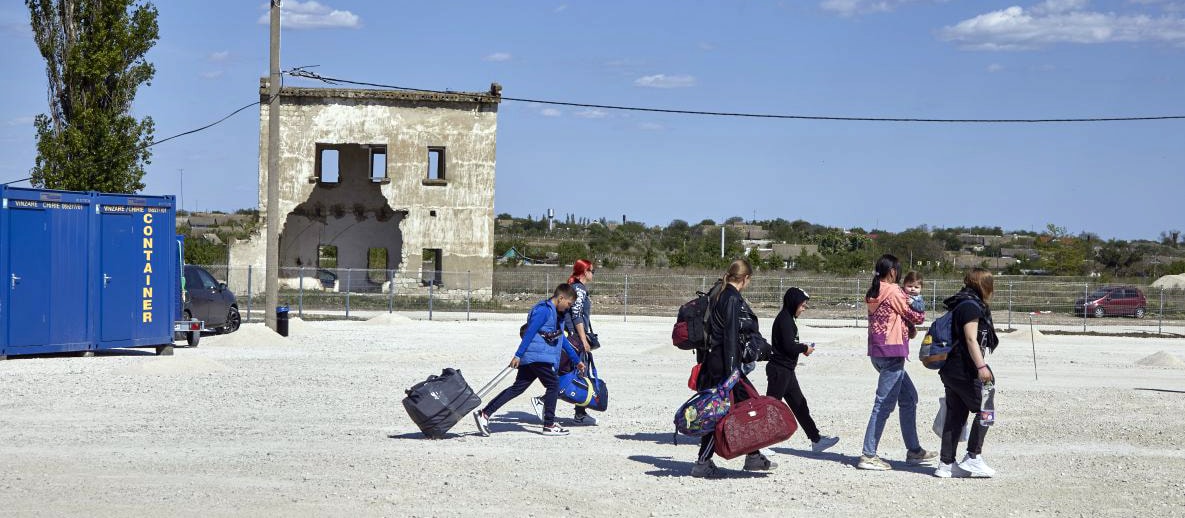At a glance
CDC works with the Ukraine Ministry of Health (MOH) and other partners to build effective public health collaboration and partnerships, which strengthen the country's core public health capabilities: data and surveillance, laboratory capacity, workforce and institutions, prevention and response, innovation and research, and policy, communications, and diplomacy. CDC and partners continue work to meet the immediate needs and support the long‐term resiliency of the Ukraine public health system.

Overview

CDC established a country office in Ukraine in 2010, initially focused on addressing the HIV epidemic. CDC continues to work closely with the Ukraine MOH, the Public Health Center of Ukraine (UPHC), and other partner organizations to detect, prevent and control infectious disease outbreaks, and build and strengthen the country's core public health capabilities. These include data and surveillance, laboratory capacity, workforce and institutions, prevention and response, innovation and research, and policy, communications, and diplomacy. CDC's work aims to protect the health of our nations and public health around the world.
CDC supports Ukraine to build and sustain effective public health systems to address public health areas including HIV, antimicrobial resistance and vaccine preventable diseases. CDC also works to meet its obligations under International Health Regulations (IHR 2005). Since Russia's invasion of Ukraine in 2022, CDC has mobilized technical and financial resources to support the resilience and continuity of the public health systems. This includes efforts to halt the spread of antimicrobial resistant pathogens among the war wounded throughout the Ukraine health system, western Europe, and beyond.
Global health security
In 2022, Ukraine accepted the designation as an Intensive Support Partner (ISP) Country for Health Security by the U.S. National Security Council. CDC’s global health security work in Ukraine focuses on supporting Ukraine to strengthen the country’s public health system and address leading public health threats. The 2022 Russian invasion of Ukraine marked a pivotal moment for the resiliency of the Ukraine public health system. With support from CDC, efforts to leverage detailed action plans on disease surveillance, laboratory systems, workforce development, biosafety and biosecurity, immunization, and other critical areas have been prioritized for system continuity and health service provision.
CDC focuses on partnering with Ukraine across the following initiatives:
National Public Health Institutes
Consolidation and organization of public health expertise and systems within a National Public Health Institute allows countries to perform essential public health functions and increase accountability and efficiency. CDC assisted Ukraine's MOH to strengthen the UPHC, which serves as an organizational home for Global Health Security programs and activities. The UPHC is responsible for ensuring the most effective allocation of limited public health resources to yield the maximum public health impact. In 2022, with support from CDC and other interagency partners, Ukraine passed key legislative reforms to facilitate greater coordination and cohesion across the public health and health system at the regional level.
Workforce development
The Field Epidemiology Training Program (FETP) is a competency-based, "learn by doing", platform for training public health professionals with the skills to investigate disease outbreaks and prevent the next pandemic. In 2018, CDC supported the establishment of the Advanced FETP in Ukraine. This is an intensive two-year training program to prepare graduates for leadership roles in public health at the national level. In 2021, a Frontline FETP was established to provide three-month training for local and community-level health workers. These cohorts of field-trained epidemiologists are enlisted to work on emergent public health needs and provide rapid epidemiological support to public health emergencies at the national and regional levels.
Since 2021, Ukraine has also participated in the Eastern Europe and South Caucasus Intermediate FETP. Despite the ongoing war with Russia, Ukraine has maintained engagement in FETP and leveraged the program to address the acute needs of the public health system and for internally displaced Ukrainians.
CDC also supports Ukraine, in collaboration with the Association of Public Health Laboratories, to implement the Global Laboratory Leadership Program (GLLP). The Ukraine GLLP launched in 2021 and models a One Health approach that recognizes the interconnection between people, animals, plants, and their shared environment. GLLP strengthens laboratory leaders' management skills and promotes sustainable and effective laboratory systems.
Key achievements
- Conducted a joint assessment, with FETP residents from Moldova, of Refugee Accommodation Centers on the Ukraine-Moldova border to assess access to health care services and mental health needs for Ukrainian refugees.
- Deployed rapid responders to support the mitigation of emerging health threats resulting from the Russian attack against the Nova Kakhovka Hydroelectric Power Plant in 2023.
- During the COVID-19 pandemic, CDC supported UPHC to establish a phone helpline, engage religious leaders to pilot a contact tracing program, and develop and implement mitigation strategies during the annual Hassidic pilgrimage in Uman, Central Ukraine.
- 44 public health professionals from 3 cohorts have graduated from Ukraine's FETP-Advanced program since 2018.
- Trained laboratory staff in biosafety and security, and supported the development of the national plan for biosafety cabinet certification, inspection, and maintenance.
HIV and TB
As a key implementer of the U.S. President's Emergency Plan for AIDS Relief (PEPFAR), CDC plays an essential role in the fight against HIV and TB. With unmatched scientific and technical knowledge and long-standing relationships with ministries of health, CDC is uniquely positioned to advance HIV, TB, and other global health security activities that keep Americans safe at home and abroad.
Through PEPFAR, CDC provides critical support to Ukraine's public health infrastructure, improving the country's ability to prevent, detect, and respond to HIV, TB, and other infectious diseases and minimizing their risk from entering the U.S.
Antimicrobial resistance (AMR)
High rates of AMR, including carbapenem resistant organisms (CRO), existed in Ukraine before the war. The increase in traumatic wounds and strained healthcare facilities has led to alarming rates of CRO infections and their heightened spread.
Patients with these multi-drug resistant infections are overwhelmingly transfers from treatment facilities closer to the frontlines in eastern Ukraine. The problem extends across the Ukrainian hospital system and is being detected in Western Europe among patients transferred for care, including into U.S. military treatment facilities. Some of these patients are being detected with highly drug resistant organisms that are uncommon in Western Europe. The U.S. CDC is supporting a response to this crisis throughout the hospital system and improving capabilities to prevent, detect and respond to healthcare-associated infections and multi-drug resistant organisms at hospitals. CDC works with the MOH, UPHC, and partners to:
- Improve the quality of AMR specimen collection, handling, and transportation.
- Strengthen the quality and speed of microbiologic testing and antibiotic susceptibility testing, and the availability of and provision of appropriate treatment regimens.
- Comply with Infection, Prevention, and Control standard operating procedures and reduce Healthcare Associated Infections (HAIs).
- Engage in routine HAI surveillance.
- Improve detection, characterization, and response to gram-negative multidrug resistant organisms.
- Develop of core capacities for conducting AMR genomic surveillance.
- Establish scalable digital solutions for rapid monitoring of microbiology laboratory data and antibiotic use at hospital and aggregate-levels.
Key achievements
- Conducted assessments to inform AMR prevention, detection, and response approaches in Ukraine.
- Facilitated biweekly clinical support and laboratory twinning meetings between AMR subject matter experts from CDC, ICAP, and European Society of Clinical Microbiology and Infectious Diseases, and Ukrainian clinicians and laboratorians.
- Purchased laboratory genomic sequencing equipment and consumables, including VITEK and MALDI-TOF machines, for the National Reference Laboratory and the Ternopil Regional CDC to boost AMR detection capabilities.
- Conducted genomic sequencing laboratory capacity training for efficient disease detection protocols and operating procedures.
Immunization
Many people in Ukraine are at increased risk of vaccine-preventable diseases due to years of low immunization coverage during the previous decade. This has been further amplified by the COVID-19 pandemic and Russia's invasion. CDC supports Ukraine's MOH to strengthen its national immunization program by addressing the following areas:
- Building technical, leadership, and management capacity.
- Improving partner collaboration and coordination.
- Revising immunization policy.
- Developing strategies to address vaccine hesitancy.
- Vaccine safety surveillance.
- Risk communication.
Key achievements
- In response to a 2021 polio outbreak, CDC helped the Ukrainian MOH strengthen polio surveillance and develop an outbreak response plan.
- CDC helped stop a 2019 measles outbreak by supporting investigations and developing recommendations and control measures.
- CDC develops strategies to address vaccine hesitancy, vaccine safety surveillance, and risk communication.
Success story spotlight
Supporting Ukraine's Children after Hospital Blast

On July 8, 2024, a Russian missile attack devastated the Okhmadtyt Children's Hospital in Kyiv, Ukraine. Four hospital staff members died. Thankfully, due to the swift actions of the staff in moving the children to shelter as soon as the air raid siren sounded, no children were harmed in the blast. However, the hospital suffered significant damage, and there is much healing still to be done.
Staff from CDC's Ukraine office joined U.S. embassy leadership at the site on July 9 to see what support the U.S. could offer in the wake of the tragic event. Because of CDC's relationship with the hospital, United States Ambassador to Ukraine Bridget Brink asked CDC to take the lead in coordinating a visit to meet with hospital leadership, patients, and families to express the U.S. government's commitment to supporting Ukraine.
Joining the Ambassador and CDC Ukraine Country Director Dr. Ezra Barzilay on the visit were U.S. Special Representative for Ukraine's Economic Recovery, Penny Pritzker, and the CEOs of three major U.S. companies who had come to Kyiv for an official visit with Pritzker. During the visit, which took place on Monday, July 29, the group witnessed the damage from the recent attack and discussed community recovery efforts. They also visited patients in the hospital's oncology ward, giving gifts to the children.
"There's a favorite Ukrainian proverb of mine that I have found to be apt throughout the years of the war," says Dr. Barzilay. "It says: In dark times, bright people shine even brighter.'"

